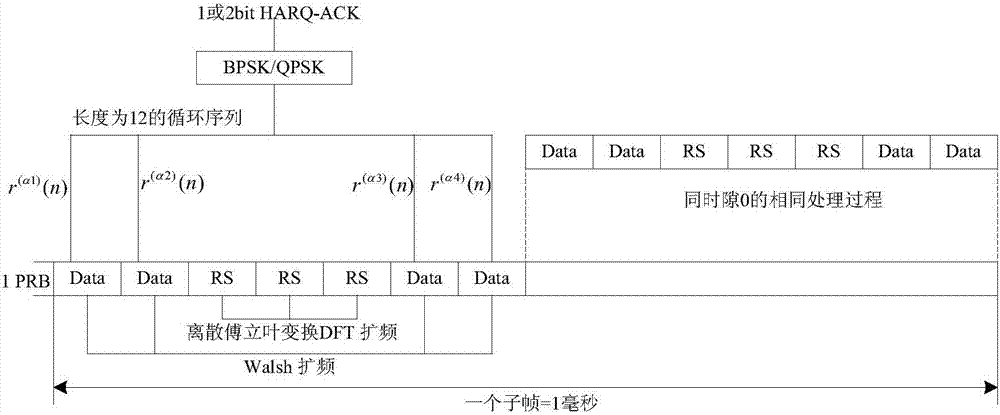Information sending method and device
A technology of information sending and waiting to be sent, which is applied in the field of communication, and can solve problems such as the inability to use it directly, the reduction of available resources for sending valid data, and the increase of reference signal overhead, so as to achieve the effect of improving available resources
- Summary
- Abstract
- Description
- Claims
- Application Information
AI Technical Summary
Problems solved by technology
Method used
Image
Examples
Embodiment 1
[0067] The main idea of the preferred embodiment 1 of the present invention is: there are sequences corresponding to N predefined reference signals, wherein the sequences corresponding to the N predefined reference signals have the same non-zero values at predetermined positions Value, N is a positive integer greater than or equal to 2; according to the information (equivalent to the information to be sent on the physical uplink channel of the above-mentioned embodiment) or a part of the information, determine the sequence corresponding to the reference signal to be sent; correspond to the determined reference signal The sequence and the above information are mapped to time-frequency resources, and the reference signal and the above information are sent on the frequency resources.
[0068]Further, the sequence corresponding to the reference signal has a constant-amplitude property in the frequency domain, or has a constant-amplitude property in the time domain, or has a con...
specific Embodiment 1
[0069] Specific embodiment 1: Assuming that the sequence corresponding to the reference signal is generated in the time domain, set sequence 1 and sequence 2 and the sequence after the Fourier transform (Discrete Fourier Transform, DFT for short) of sequence 1 and sequence 2 as shown in Table 1 below :
[0070] Table 1
[0071] n
[0072] It can be seen from the above Table 1 that the Fourier-transformed sequences of sequence s1 and sequence s2 are the same at the first and seventh positions (corresponding to n=0 and n=6 respectively), that is, no matter Whether the sending end sends the sequence s1 or the sequence s2, the sequence received by the receiving end is the same at the first and seventh positions in the frequency domain. Using the above characteristics, the receiving end can perform channel estimation at the two positions , and then use the channel estimates obtained at these two positions to perform interpolation to obtain the frequency domain estimation ...
specific Embodiment 2
[0073] Assuming that the sequence corresponding to the reference signal is generated in the frequency domain, set sequence 1 and sequence 2 as shown in Table 2 respectively:
[0074] Table 2
[0075] n
s1
s2
0
0.7071-0.7071i
0.7071-0.7071i
1
0.7071+0.7071i
-0.7071-0.7071i
2
-0.7071+0.7071i
-0.7071+0.7071i
3
-0.7071-0.7071i
0.7071+0.7071i
4
-0.7071+0.7071i
-0.7071+0.7071i
5
-0.7071+0.7071i
0.7071-0.7071i
6
0.7071+0.7071i
0.7071+0.7071i
7
0.7071+0.7071i
-0.7071-0.7071i
8
-0.7071+0.7071i
-0.7071+0.7071i
9
0.7071+0.7071i
-0.7071-0.7071i
10
-0.7071-0.7071i
-0.7071-0.7071i
11
-0.7071+0.7071i
0.7071-0.7071i
[0076] It can be seen from the above Table 2 that the sequence s1 and sequence s2 are the same on n=0 / 2 / 4 / 6 / 8 / 10, that is to say, no matter whether the sender sends sequence s1 or sequence s2, The sequences received ...
PUM
 Login to View More
Login to View More Abstract
Description
Claims
Application Information
 Login to View More
Login to View More - R&D
- Intellectual Property
- Life Sciences
- Materials
- Tech Scout
- Unparalleled Data Quality
- Higher Quality Content
- 60% Fewer Hallucinations
Browse by: Latest US Patents, China's latest patents, Technical Efficacy Thesaurus, Application Domain, Technology Topic, Popular Technical Reports.
© 2025 PatSnap. All rights reserved.Legal|Privacy policy|Modern Slavery Act Transparency Statement|Sitemap|About US| Contact US: help@patsnap.com



